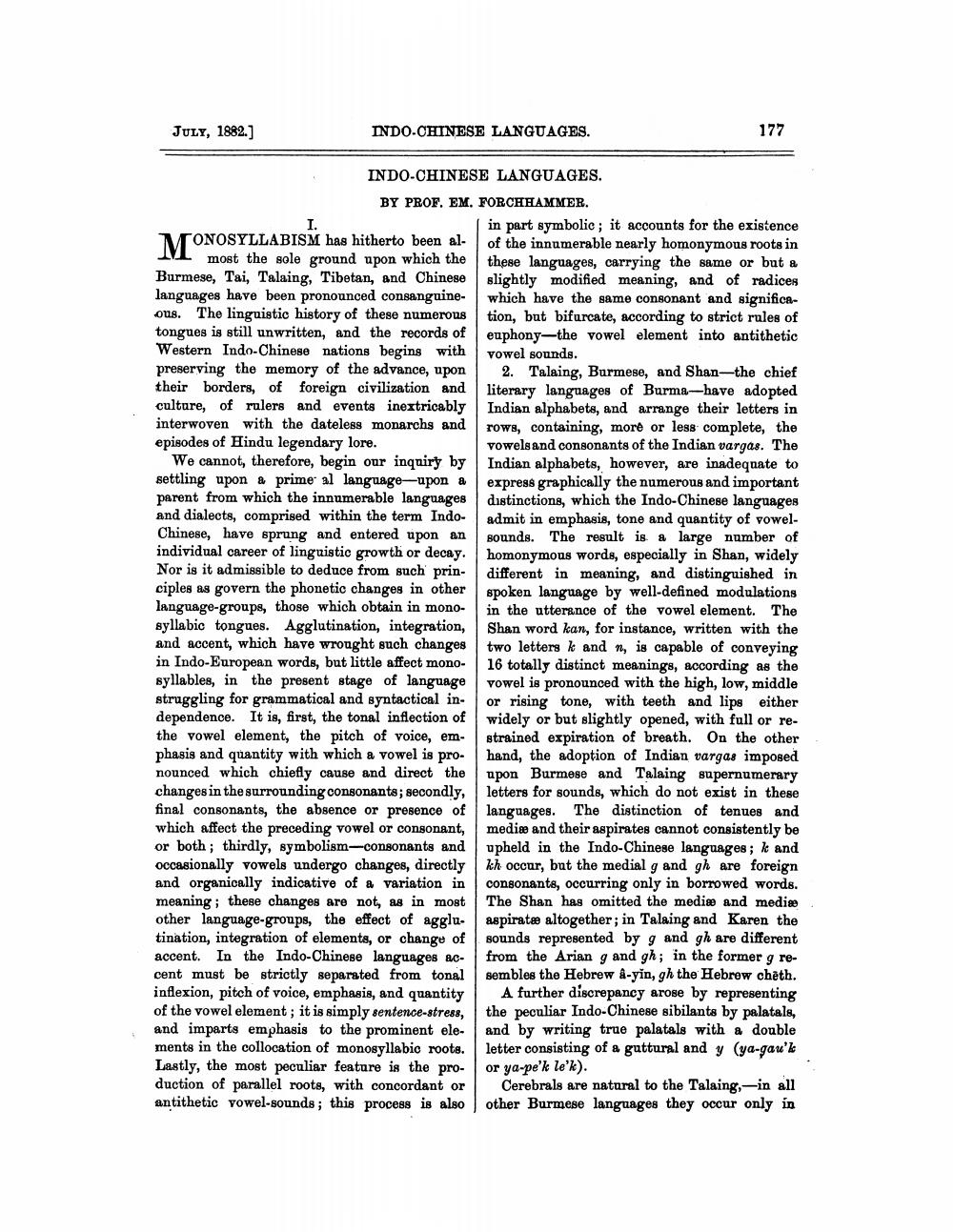________________
JULY, 1882.]
INDO-CHINESE LANGUAGES.
177
INDO-CHINESE LANGUAGES.
BY PROF. EM. FORCHHAMMER.
in part symbolic; it accounts for the existence M ONOSYLLABISM has hitherto been all of the innumerable nearly homonymous roots in most the sole ground upon which the
these languages, carrying the same or but a Burmese, Tai, Talaing, Tibetan, and Chinese slightly modified meaning, and of radices languages have been pronounced consanguine- which have the same consonant and significaous. The linguistic history of these numerous tion, but bifurcate, according to strict rules of tongues is still unwritten, and the records of euphony-the vowel element into antithetic Western Indo-Chinese nations begins with vowel sounds. preserving the memory of the advance, upon 2. Talaing, Burmese, and Shan—the chief their borders, of foreign civilization and literary languages of Burma-have adopted culture, of rulers and events inextricably Indian alphabets, and arrange their letters in interwoven with the dateless monarchs and rows, containing, more or less complete, the episodes of Hindu legendary lore.
vowels and consonants of the Indian vargas. The We cannot, therefore, begin our inquiry by Indian alphabets, however, are inadequate to settling upon a prime al language-upon a express graphically the numerous and important parent from which the innumerable languages distinctions, which the Indo-Chinese languages and dialects, comprised within the term Indo- admit in emphasis, tone and quantity of vowelChinese, have sprung and entered upon an Bounds. The result is a large number of individual career of linguistic growth or decay. homonymous words, especially in Shan, widely Nor is it admissible to deduce from such prin- different in meaning, and distinguished in ciples as govern the phonetic changes in other spoken language by well-defined modulations language-groups, those which obtain in mono
in the utterance of the vowel element. The syllabic tongues. Agglutination, integration, Shan word kan, for instance, written with the and accent, which have wrought such changes two letters k and n, is capable of conveying in Indo-European words, but little affect mono- 16 totally distinct meanings, according as the syllables, in the present stage of language vowel is pronounced with the high, low, middle struggling for grammatical and syntactical in- or rising tone, with teeth and lips either dependence. It is, first, the tonal inflection of widely or but slightly opened, with full or rethe vowel element, the pitch of voice, em- strained expiration of breath. On the other phasis and quantity with which a vowel is pro- hand, the adoption of Indian vargas imposed nounced which chiefly cause and direct the upon Burmese and Talaing supernumerary changes in the surrounding consonants; secondly, letters for sounds, which do not exist in these final consonants, the absence or presence of languages. The distinction of tenues and which affect the preceding vowel or consonant, media and their aspirates cannot consistently be or both; thirdly, symbolism-consonants and upheld in the Indo-Chinese languages; k and occasionally vowels undergo changes, directly kh occur, but the medial g and gh are foreign and organically indicative of a variation in consonants, occurring only in borrowed words. meaning; these changes are not, as in most The Shan has omitted the media and mediæ other language-groups, the effect of agglu. aspiratæ altogether; in Talaing and Karen the tination, integration of elements, or change of sounds represented by g and gh are different accent. In the Indo-Chinese languages ac- from the Arian g and gh; in the former g recent must be strictly separated from tonal sembles the Hebrew &-yin, gh the Hebrew cheth. inflexion, pitch of voice, emphasis, and quantity A further discrepancy arose by representing of the vowel element; it is simply sentence-stress, the peculiar Indo-Chinese sibilants by palatals, and imparts emphasis to the prominent ele- and by writing true palatals with a double ments in the collocation of monosyllabio roote. letter consisting of a guttural and y (ya-gau'k Lastly, the most peculiar feature is the pro- or ya-pe'k le'k). duction of parallel roots, with concordant or cerebrals are natural to the Talaing-in all antithetic vowel-sounds; this process is also other Burmese languages they occur only in




